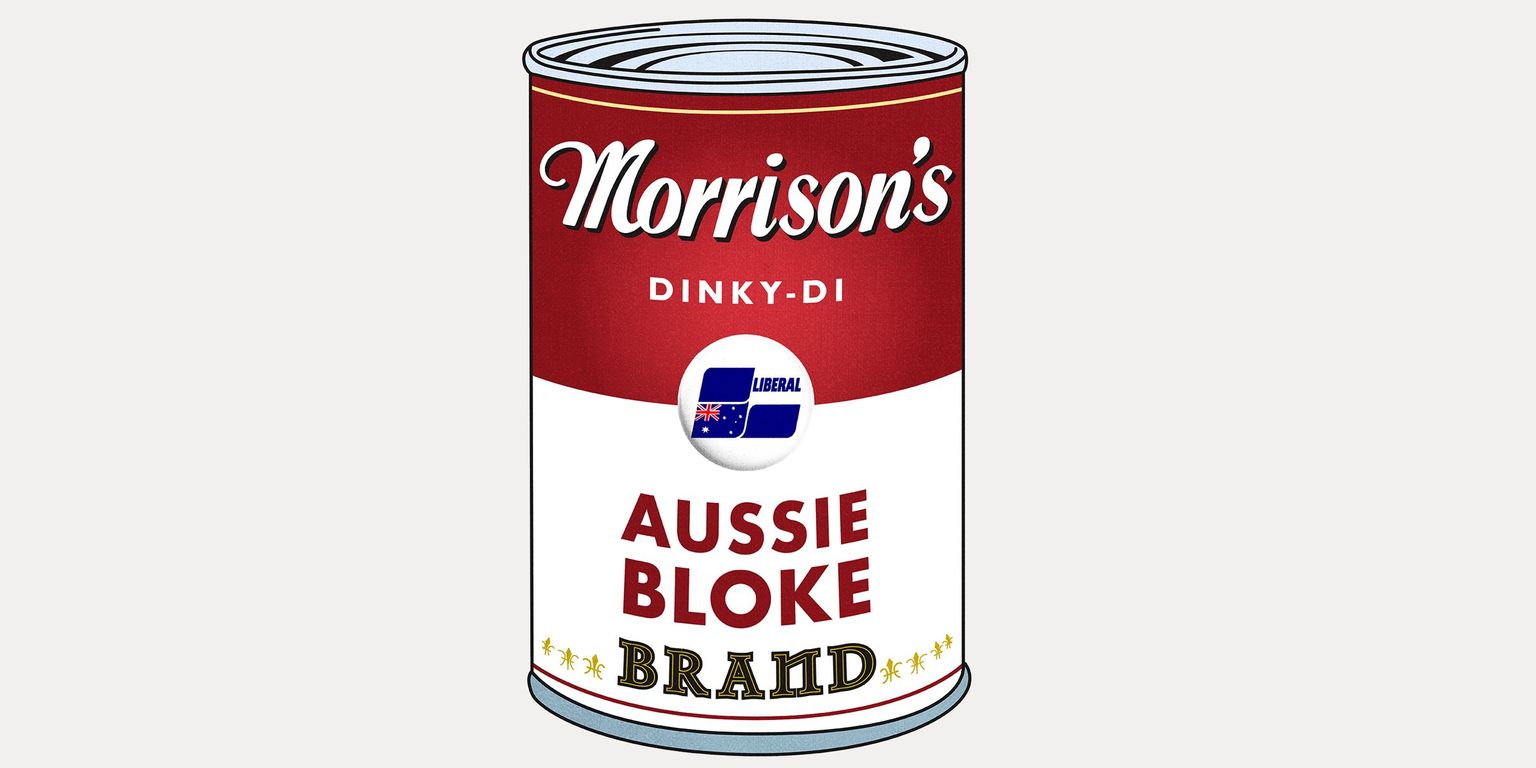Battle of the brands: how today’s politicians are sold as products on a shelf
If Labor versus Liberal sometimes feels like Campbell’s Soup vs Heinz, that’s no accident.

Illustration by Emily Thiang
It was the music performance that launched a thousand memes: Scott Morrison, ukulele in hand, lightly mangling Dragon’s ‘April Sun in Cuba’. The prime minister was roundly mocked for his 60 Minutes appearance, and not just by the Dragon bandmates themselves. As many noted, the ukulele served as an unfortunate reminder of Morrison’s Hawaiian holiday during the Black Summer bushfires. Yet for all the tweets and op-eds ridiculing Morrison, there were those who saw the song and dance routine in a more positive light.
Dr Lorann Downer was one such person. A former political journalist and Labor staffer with a background in political branding, Downer thought that Morrison’s performance actually made a lot of sense—at least when viewed through the prism of brand theory. “When I saw Morrison with the ukulele, I thought, ‘Aha, this is an attempt to re-establish an emotional connection with people who’ve turned away from him’. He was happy to play and sing badly to try to reconnect in a very human way with every person who's ever done that.”
To understand why flubbing a classic rock song could be seen as strategic, Downer says we need to understand a thing or two about branding, and how it’s increasingly being applied to politics.
In many ways, political branding is exactly what it sounds like: the use of techniques traditionally used in commercial marketing, repurposed to help politicians and political parties secure a person’s vote. Logos and slogans are the most obvious expressions, but at its core a brand is simply a promise—one that sets a consumer’s expectations about what they’ll get if they choose you over your competitors. And while some baulk at the overt productisation of politics, Downer says every successful politician practices branding in some way, whether they do it consciously or not.
“In Western democracies over the past several decades, we've seen an increasing turn towards branding for one simple reason: it works,” Downer says. A brand can tell a complex story with breathtaking simplicity using only a name, a symbol or a few words that spark a response. (See Obama’s ‘Hope’ slogan, or Trump’s ‘Make America Great Again’.) “For parties and politicians, branding provides a way to sum up the complexity of their offerings. For voters, it offers a shortcut to navigate the complexity of their choices.”
Your brand is a psychological construct; it's whatever your consumers believe it is.
Downer points to Kevin07 as the high watermark for political branding in Australia. “There was a lot of work over the course of a year to establish the values of both the Kevin07 brand and the Labor Party brand, and to work out how they could be connected together,” she says. “There was a very careful targeting of voter segments and very careful marketing communications to those voter segments. It was sophisticated and disciplined and brilliantly done.”
True to his moniker as Scotty from Marketing, Morrison’s approach to his own branding has shifted over his political career. As his biographer Sean Kelly discussed in a recent episode of the 7am podcast, Morrison’s early tenure as immigration minister saw him establish a restrictive, hard-nosed brand that was all about stopping the boats. He rarely talked about himself. That all changed when he shifted to the Social Services portfolio at the end of 2014, and we saw the ‘ScoMo’ brand begin to emerge. “After 2015, [Morrison] learns very much that he has to shape a narrative about himself,” Kelly says. “He is going to attract a lot of attention. He can't bat questions away forever. And that's when you really start to hear him talk a lot about cooking curries and start to talk a lot about the football and the Cronulla Sharks.”
Brand ScoMo worked wonders—Morrison enjoyed some of the highest approval ratings a PM had seen in ten years—until it didn’t. “The image morphed from ScoMo to SlowMo,” Downer says, after Morrison's lacklustre response to successive natural and public health disasters. “People suddenly went, ‘Hang on, my house is burning down and he's gone off to Hawaii. That's not what your everyday Aussie bloke would do. He'd stick around and hold a hose and help me put out that fire.” Morrison had betrayed his brand promise. “And once there's been a shift in the consumer perception of a brand, it's very hard to change it back, because your brand is a psychological construct; it's whatever your consumers believe it is. Even though you create a brand, your consumers actually own it, and they determine whether it lives or dies.”
For proof, Downer says we need only look at the one-time master of political branding, Kevin Rudd. After the wild success of his Kevin07 campaign, Rudd might have expected the kind of long-lasting popularity enjoyed by Howard before him. But when the public came to realise Rudd may not have been the quiet, well-mannered figure his branding made him out to be, they no longer knew what his brand stood for. And this, Downer says, is where everything started to go wrong. “A brand that is inconsistent will confuse voters, and a brand that is inauthentic will alienate voters.” By 2013, voters were confused and alienated by Rudd’s supposedly revamped brand, and they abandoned it in droves. Ten years later, the failure of his prime ministership stands as a cautionary tale about the importance of authenticity in branding.
After three years in the spotlight, it looks like Morrison has embarked down the same path, his brand fatally at odds with his actions and his reputation tarnished by a stream of colleagues who have described him not merely as out of touch, but as a ruthless, lying bully. Enter the ukulele-playing, curry-loving Sharks fan. “When your brand has been damaged, you need to try to reconnect with your consumers,” Downer says. “And the way to do that is through emotion. Because that's how people relate to any brand—emotionally first, rationally second.”
The failure of [Rudd's] prime ministership stands as a cautionary tale about the importance of authenticity in branding.
We may never know if Morrison's 60 Minutes performance successfully resurrected his average bloke image; even if it did cause voters to soften their stance towards the PM, it’s highly unlikely any brand revival would be enough to secure victory for Morrison on its own. That’s because Morrison doesn't just need to revive his own brand; he also needs to pollute his opponent’s. And for much of the past three years that has proved difficult, because of Albanese’s steadfast and strategic refusal to define his own brand offering.
“Normally, you’d build your brand throughout a political cycle, so when it comes to the formal campaign your brand building is done and the people have a very solid view of who you are,” Downer says. “But Albanese has left it quite late in the political cycle to fully define his brand.” Recently, ‘Albo’ has made some late attempts at brand building; he’s promised to govern in the style of Bob Hawke, and started to put more effort into his physical appearance, losing weight, donning new glasses and tailoring his suits—efforts Morrison has tried to turn against him by branding Albanese as an inauthentic shape-shifter.
Some, like Sean Kelly, argue that the media’s dogged focus on Albanese’s now-famous gaffe in the first week of the campaign was, while unfair and trivial, also largely of the Labor leader’s own making. “Albanese brought this on himself,” Kelly says. “The mistakes were spontaneous, but their impact was in part the consequence of his earlier decision to adopt a small-target strategy. Until now, that decision had seemed cost-free. It wasn’t. A large policy offering, made months ago, would have told voters what Labor planned to do, reassuring them; made them feel they knew who Albanese was, rendering campaign mistakes less important.”
A Labor victory on May 21 could shift the conventional thinking about whether politicians can build a brand in a relatively short time. But even if Albanese wins, as he is currently tipped to (or at least was when we published this article), his ability to build a good brand will only have been one contributing factor among many. That’s because of the one key difference between commercial and political branding: choice. A thirsty consumer doesn’t actually have to choose between Coke and Pepsi—in addition to all the other competitors before them, they can walk out of the store empty-handed. In a country with mandatory voting, consumers have to make a ‘purchase’. The inability to opt out fundamentally changes the decision-making process, meaning Albanese can likely bank on a certain number of votes irrespective of how well he brands himself.
Perhaps with this in mind, Albanese decided to keep his brand small, hoping that Morrison’s failure to maintain brand fidelity will continue to do the work for him. “As the old maxim goes, don't interrupt your enemy when he is making a mistake,” Downer says. Except, of course, when the person making the mistake is you.
5 branding principles to help you win an election
Build an authentic brand you can sustain
Authenticity is the bedrock of any brand. A brand that is seen as authentic will be elevated above its competitors, and every claim that is made by and for the brand will be more believable. Albanese has always presented authentically, despite Morrison’s efforts to cast him as a shapeshifter for losing weight and sporting new glasses. As a result, when he says he knows the value of a dollar because he was raised by a single mum in public housing, people believe him.
Be crystal clear about your brand values
Properly articulated brand values will frame your offerings (in this case, your policies), identify your competitors and establish points of difference and points of parity between you and your opponent. In the 2022 election, the conservatives are using their traditional economic values to create a point of difference with Labor, positioning the Liberal Party as good economic managers (and Labor as the opposite).
Marry heart and head
Consumers respond to brands emotionally first, rationally second. If you can form a deep emotional connection with a consumer, you’ll create long-lasting loyalty that can resist challenge from your competitors. Two emotions dominate in political campaigns: fear and hope. Morrison is invoking fear of Albanese, playing on economic insecurity and the generalised anxiety felt by some in the wake of the pandemic to drive home his point of difference on economic management. It’s a powerful emotional connection that may well trump rational arguments about Labor’s economic credentials.
Deliver on your brand promise (or explain why you can’t)
A brand that fails to deliver on its promises without adequate explanation risks post-purchase dissonance, with electors feeling they didn’t get what they voted for. Morrison failed to deliver on his brand promise of ‘the bloke next door’ during the devastating bushfires in the summer of 2019. And his first attempt at explaining—“I don’t hold a hose, mate”—wasn’t just inept, it was brand-damaging and brand-defining.
If your brand becomes tainted, cleanse
You can build your brand, but only your voters can own it. Your brand is whatever they say it is. And if they say it’s dirty, you have to cleanse it, usually via an apology or some other reset. That’s why we saw Albanese quickly do a mea culpa for his failure to recall the official cash rate and unemployment rate on day one of the official election campaign.
